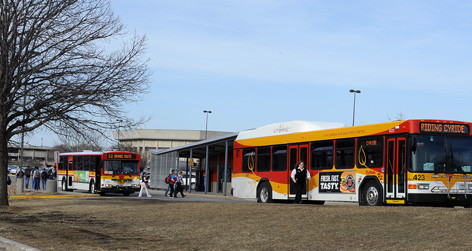
CyRide buses bunch up in Iowa State Center commuter lots. Next fall, a couple of long, articulated buses will help ease congestion at these busy lots. Photo by Bob Elbert.
According to the averages, CyRide buses should provide something like 16.4 rides per capita in a year. That's the national average for small urban transit systems in communities with populations under 200,000.*
CyRide, to put it mildly, is above average. Last year, the ISU-Ames community bus system provided 106 rides per capita -- the same ridership as Washington D.C.'s transit system.*
That stat pushes CyRide to the No. 1 spot in ridership among small transit systems nationally. It's an honor the local transit system may repeat this year.
CyRide buses tallied 5.4 million rides in 2011, according to CyRide transit director Sheri Kyras. She estimates ridership will climb for the sixth straight year, hitting 5.8 million this year.
CyRide's success attracts attention, particularly from other university communities. Kyras said she gets many calls about the bus system, and recently hosted a visit from city officials, students and media from Columbia, Mo.
"We're a unique model around the country," Kyras said. "I attribute that to a university and city that work very well together. You don't always see that around the country."
A good idea in 1982, and now
CyRide began in 1982 with a visionary idea -- that students, university and city would put money into a new transit system, Kyras said. In most places, a single entity, such as the city or university, funds and runs the transit system.
The cost-sharing arrangement in Ames has provided CyRide with the funding to be successful and to run its buses more frequently than other communities, Kyras said.
The Government of the Student Body (GSB) is by far the largest CyRide funder, kicking in a subsidy that allows all students to ride free. Eighty-nine percent of riders are students.
ISU parking also partially subsidizes bus passes for faculty and staff. Employees have a number of CyRide pass options. For example, employees could buy semester CyRide passes for $90 last September, and approximately 250 employees did just that.
There are 125 drivers wheeling around in CyRide buses. More than half are ISU students. All drivers must undergo 140 hours of rigorous training and get a commercial driver license, Kyras said.
What's next?
Kyras said over the coming year CyRide passengers will see a couple of innovations on their favorite bus system.
- Articulated buses. These extra-long buses with a flexible accordion-like center sections will be maneuvering Ames intersections next fall. Kyras said two of the 62-foot buses (normal buses are 40 feet) will be added to the CyRide fleet. She anticipates the buses will be on the orange route, helping to ease congestion at busy stops at the Iowa State Center commuter lots and residence halls.
- Smartphone app en route: By next fall or spring, riders should be able to use their smartphones to track the progress of their buses on their routes. GSB is funding development of the app, which will track all the CyRide buses in real time.
* Figures are from the Federal Transit Administration report, "FTA Fiscal Year 2012 Apportionments, Allocations, and Program Information."

